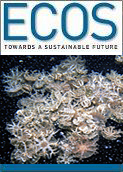
|
Published: 17 September 2012
More research needed on effects of forest mortality
There are significant gaps in our knowledge of the potential effects of forest die-offs triggered by hot and dry conditions, says a new study.

|
|
In south-east Alaska and nearby British Columbia, yellow-cedar decline affects approximately 60-70 per cent of trees in forests covering 600,000 acres. The die-off of trees of this iconic and valuable species has been linked to climate change. A new study finds that more research is needed on the effects of forest die-offs triggered by changed climatic conditions. Credit:
US Department of Agriculture. Licensed under a Creative Commons Attribution Generic License.
|
Over the past two decades, extensive forest death triggered by hot and dry climatic conditions has been documented on every continent except Antarctica. Forest mortality due to drought and heat stress is expected to increase due to climate change. Although research has focused on isolated incidents of forest mortality, little is known about the potential effects of widespread forest die-offs. A new analysis of the current literature on this topic has been published in Nature Climate Change.
The authors examined scientific papers dealing with different aspects of forest die-off events all over the world. They divided their findings into the effects on a forest community of trees and other species; on ecosystem processes as a whole; on services forests provide to humans; and on the climate.
‘This study provides a state-of-the-art overview of the many benefits forests provide to humans, from water purification to climate regulation,’ says co-author William Anderegg of the Carnegie Institution for Science.
‘Many of these roles can be disrupted by the widespread tree mortality expected with climate change.’
The authors found that heat and drought, including drought-related insect infestation, can disproportionately affect some species of trees, or can impact certain ages or sizes of trees disproportionately. This can result in long-term shifts in an area's dominant species, with the potential to trigger a transition into a different ecosystem, such as grassland.
Heat and drought can also impact the understory – the layer of vegetation under the treetops – as well as organisms living in the soil. From an ecosystem perspective, forest die-off is also likely to affect hydrological processes and nutrient cycles. Depending on the type of forest, soil moisture could be increased by the lack of tree-top interception of rainfall, or decreased by evaporation due to increased exposure to the sun and wind. Debris from fallen trees could also increase a forest's fire risk.
Forests also have an effect on the climate as a whole. On one hand, forest mortality increases the reflection of the sun's energy back into space, thus providing a cooling effect. But on the other hand, the decomposition of fallen trees releases carbon into the atmosphere, thus producing a warming effect. Overall, whether forest die-offs result in local cooling or warming is expected to depend on the type of forest, the latitude, the amount of snow cover, and other complex ecosystem factors.
Mass tree mortality would likely cause substantial losses to the timber industry, even if saplings and seedlings were unaffected. Little research has been conducted on other types of forest products that humans use, such as fruit or nuts.
Overall, the analysis found that despite advances in understanding the effects of severe forest die-off, critical research gaps remain. In particular more research is needed on trajectories of regrowth after die-off.
‘The varied nature of the consequences of forest mortality means that we need a multidisciplinary approach going forward, including ecologists, biogeochemists, hydrologists, economists, social scientists, and climate scientists,’ says Mr Anderegg.
Source: Carnegie Institution for Science



